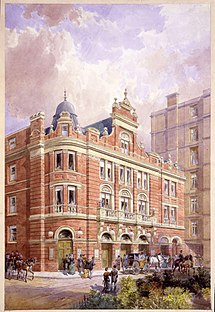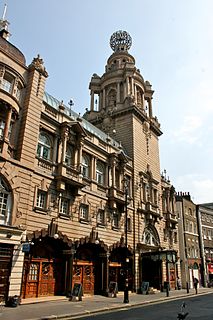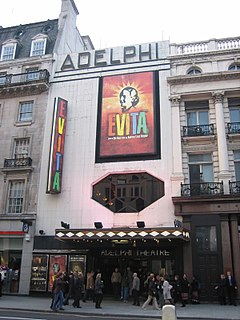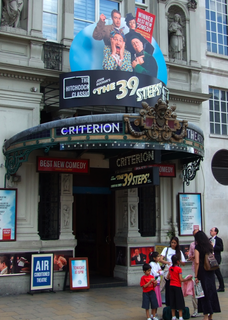
The Savoy Theatre is a West End theatre in the Strand in the City of Westminster, London, England. The theatre opened on 10 October 1881 and was built by Richard D'Oyly Carte on the site of the old Savoy Palace as a showcase for the popular series of comic operas of Gilbert and Sullivan, which became known as the Savoy operas as a result.

The London Coliseum is a theatre in St Martin's Lane, Westminster, built as one of London's largest and most luxurious "family" variety theatres. Opened on 24 December 1904 as the London Coliseum Theatre of Varieties, it was designed by the theatrical architect Frank Matcham for the impresario Oswald Stoll. Their ambition was to build the largest and finest music hall, described as the "people's palace of entertainment" of its age.

The Adelphi Theatre is a London West End theatre, located on the Strand in the City of Westminster. The present building is the fourth on the site. The theatre has specialised in comedy and musical theatre, and today it is a receiving house for a variety of productions, including many musicals. The theatre was Grade II listed for historical preservation on 1 December 1987.

Cork Opera House is a theatre and opera house in Cork in Ireland. The first venue opened in 1855 on Emmet Place to the rear of the Crawford Art Gallery. This original building was destroyed by fire in 1955, and a replacement opened in 1965. With a number of additions in the early 21st century, the 1000-seat venue hosted over 100 theatre, music, opera, and comedy events in 2015.

West End theatre is mainstream professional theatre staged in the large theatres in and near the West End of London. Along with New York City's Broadway theatre, West End theatre is usually considered to represent the highest level of commercial theatre in the English-speaking world. Seeing a West End show is a common tourist activity in London.

The Theatre Royal, Drury Lane, commonly known as Drury Lane, is a West End theatre and Grade I listed building in Covent Garden, London, England. The building faces Catherine Street and backs onto Drury Lane. The building is the most recent in a line of four theatres which were built at the same location, the earliest of which dated back to 1663, making it the oldest theatre site in London still in use. According to the author Peter Thomson, for its first two centuries, Drury Lane could "reasonably have claimed to be London's leading theatre". For most of that time, it was one of a handful of patent theatres, granted monopoly rights to the production of "legitimate" drama in London.

The Criterion Theatre is a West End theatre at Piccadilly Circus in the City of Westminster, and is a Grade II* listed building. It has a seating capacity of 588.

The culture of Birmingham is characterised by a deep-seated tradition of individualism and experimentation, and the unusually fragmented but innovative culture that results has been widely remarked upon by commentators. Writing in 1969, the New York-based urbanist Jane Jacobs cast Birmingham as one of the world's great examples of urban creativity: surveying its history from the 16th to the 20th centuries she described it as a "great, confused laboratory of ideas", noting how its chaotic structure as a "muddle of oddments" meant that it "grew through constant diversification". The historian G. M. Young – in a classic comparison later expanded upon by Asa Briggs – contrasted the "experimental, adventurous, diverse" culture of Birmingham with the "solid, uniform, pacific" culture of the outwardly similar city of Manchester. The American economist Edward Gleason wrote in 2011 that "cities, the dense agglomerations that dot the globe, have been engines of innovation since Plato and Socrates bickered in an Athenian marketplace. The streets of Florence gave us the Renaissance and the streets of Birmingham gave us the Industrial Revolution", concluding: "wandering these cities ... is to study nothing less than human progress."

The Birmingham Hippodrome is a theatre situated on Hurst Street in the Chinese Quarter of Birmingham, England.

The Alexandra, commonly known as the Alex, is a theatre on Suffolk Queensway in Birmingham, England.

The culture of London concerns the music, museums, festivals and lifestyle within London, the capital city of the United Kingdom. The city is particularly renowned for its theatre quarter, and its West End theatre district has given the name to "West End theatre", the strand of mainstream professional theatre staged in the large theatres in London. London is also home to notable cultural attractions such as the British Museum, the Tate Galleries, the National Gallery, the Notting Hill Carnival and The O2.

The Queensland Performing Arts Centre is part of the Queensland Cultural Centre and is located on the corner of Melbourne Street and Grey Street in Brisbane's South Bank precinct.

The Auditorium Theatre is a music and performance venue located inside the Auditorium Building at 50 Ida B. Wells Drive in Chicago, Illinois. Inspired by the Richardsonian Romanesque Style of architect Henry Hobson Richardson, the building was designed by Dankmar Adler and Louis Sullivan and completed in 1889. The Chicago Symphony Orchestra performed in the theatre until 1904 as well as the Chicago Grand Opera Company and its successors the Chicago Opera Association and Chicago Civic Opera until its relocation to the Civic Opera House in 1929. The theatre currently hosts performances by the Joffrey Ballet, in addition to a variety of concerts, musicals, performances and events. Since the 1940s, it has been owned by Roosevelt University and since the 1960s refurbished and managed by an independent non-profit arts organization.

The Theatre Royal is the oldest theatre in Glasgow and the longest running in Scotland. Located at 282 Hope Street, its front door was originally round the corner in Cowcaddens Street. It currently accommodates 1,541 people and is owned by Scottish Opera. The theatre opened in 1867, adopting the name Theatre Royal two years later. It is also the birthplace of Howard & Wyndham Ltd, owners and managers of theatres in Scotland and England until the 1970s, created by its chairman Baillie Michael Simons in 1895. It was Simons who as a cultural entrepreneur of his day also promoted the building of Kelvingrove Art Gallery and Museum and Glasgow's International Exhibitions of 1888 and 1901.

The O2 Institute (originally known as the Digbeth Institute) is a music venue located in Birmingham, England. The venue opened in 1908 as a mission of Carrs Lane Congregational Church. It has also served as an event centre, civic building and nightclub.

Bedlam Theatre is a fully operational, 90-seat theatre housed in a former Neogothic church at the foot of George IV Bridge in central Edinburgh. It is owned by the University of Edinburgh, and notable for being the oldest student-run theatre in Britain. During the summer, Bedlam Fringe is run as a separate enterprise, Bedlam being a long-standing Edinburgh Fringe venue.

Julius Alfred Chatwin FRIBA, ARBS, FSAScot was a British architect. He was involved with the building and modification of many churches in Birmingham, and practised both Neo-Gothic and Neo-Classical styles. His designs always included all of the carvings and internal fittings.

The Crescent Theatre is a multi-venue theatre run mostly by volunteers in Birmingham City Centre. It is part of the Brindleyplace development on Sheepcote Street. It has a resident company, one of the oldest theatre companies in the city, and also hires its three performance spaces to a host of visitors each year, nationally and internationally, both amateur and professional.

The Temple Theatre is an historic performance center in Sanford, Lee County, North Carolina. The Temple Theatre was built in 1925 by Robert Ingram, Sr., at a time when Sanford had a population of only 3,500. The name "Temple" comes from being located next door to what was once Sanford's Masonic Lodge. The following quote ran in a 1925 issue of the Sanford Express, "In erecting this modern theater, he has spared no expense to make it an up-to-date playhouse." It is a 50 feet wide-by-92 feet deep, two-story, brick building decorated with cut stone details in a blend of Colonial Revival and Art Deco styles.

Birmingham is an important centre for theatre in the United Kingdom. The earliest known performances in the city were medieval pageants and miracle plays. Birmingham's first permanent theatres and theatrical companies were founded in the 1740s, drawing both actors and performance styles from the fashionable theatres of London. During World War II, the Birmingham Blitz forced all performance venues in the city to close; most would stay closed throughout the war. The postwar introduction of television led to further theatre closures.





















